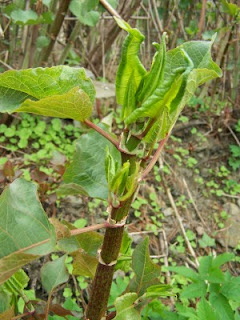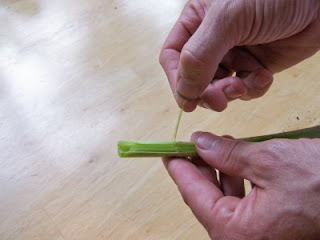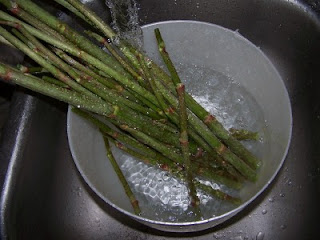Here is a closer picture of the shoot coming up out of the ground. You'll notice the many joints (poly = many, gonum = knees) along the stalk.
We stripped the heart shaped leaves from the stalk, which is the part we wanted to juice. The stalk is mottled, or speckled with red, and hollow:
The stalks can be peeled, which is definitely recommended if you are eating it raw, or even preparing it by steaming. The outer part is very stringy and tough.
Since we were putting them though a juicer, though, we did not peel all the stalks. Here they are in the sink being washed:
Here is Ella juicing them:
The result was a vibrant green tart tasting juice. It would have been fine to drink on it's own, but we added some juiced apples. Though the apples we added were red (gala, I believe) the result tasted exactly like juice from Granny Smiths - very delicious!
Japanese Knotweed contains resveratrol, which is a beneficial nutrient for the heart and brain. Resveratrol is what makes drinking red wine beneficial, though there is more resveratrol in Japanese Knotweed than red wine. The resveratrol supplements are usually made using Japanese Knotweed. The concentration is highest in the roots, but is still present in the stalk.
People have also begun using Japanese Knotweed as prevention and/or treatment for Lyme's disease. For more information on this check out Stephen Herrod Buhner's book Healing Lyme, which you can find, along with other information about Japanese Knotweed and Lyme disease, at his website, Buhner Healing Lyme.
Now is the time to harvest Japanese Knotweed, if you are interested in steaming, munching on, or juicing the stalks! Best to get them as young shoots, before they become tough and woody, which will be in about a month.
Enjoy!
~ Melissa Sokulski







Looks tasty! Do you have any information on the oxalic acid content in knotweed?
ReplyDeleteHi Alexandra,
DeleteI didn't have any information off hand, so I searched online and found this on Wikipedia, "Similarly to rhubarb, knotweed contains oxalic acid, which when eaten may aggravate conditions such as rheumatism, arthritis, gout, kidney stones or hyperacidity."
Looks tasty! Do you have any information on the oxalic acid content in knotweed?
ReplyDeleteDear Melissa,
ReplyDeleteI love Japanese knotweed, but haven't found any here in Kansas City (oddly enough!). I shall have to go searching farther afield!
Thank you for this great post,
Marqueta G.
You're welcome! Thanks so much for your comment!
DeleteThank you! I have kidney stones and try to avoid too much oxalic acid. I wondered since many knotweed recipes seem to use it in place of rhubarb.
ReplyDeleteYour music is amazing. You have some very talented artists. I wish you the best of success.
ReplyDeletejuicer reviews
I am interested in eating/juicing the leaves. Is this where the oxalic acid is concentrated? How would cooking effect the edibility of the leaves? I read that the Cherokee cooked and ate the leaves.
ReplyDeleteI am wondering if after juicing you put the pulp in your compost?Is there any worry of it spreading?
ReplyDelete